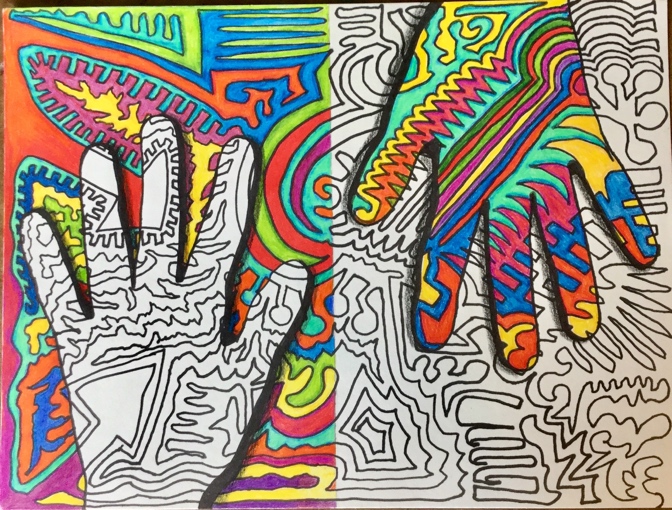
Beginning Art Project
Art 1 Project
Art 2 Project
This Project is to illustrate the Power of a Line. The project begins with a continuous line that will eventually fill up the entire page. The trick is not to get caught in a corner or cross over to get out of the corner. I know the Art 1 example shows the exact opposite, regarding my initial instructions. I made a decision to alter the project after drawing that example. Reason? Because taking more time to think about what you are doing is “planned out” not random, so I decided to change it. A few tips before you get started.
This is an example of getting caught in a corner and crossing over.
These three examples show the power of a Vertical Line implying strength, a Horizontal Line implying serenity, and a Diagonal Line implying action.
While your’re drawing the Continuous Line, you can take breaks to think about where you want to go next, but you must continue where you left off.
This is an example of what your project should resemble when finished.
The next step is to put your hand on your paper and outline with a pencil. Make sure your fingers are spread apart. The Art 2 Project requires you to use a ruler to divide your paper in half (lightly) and trace your hands on both sides, making sure you use the same hand so your thumbs are pointing inward. *The first 2 examples show my hand is traced on the other side of the paper. You can choose which side you would like your hand to be on. In class I had students draw their hands on the left side, as shown above.
Example of a traced hand.
The next step is to take your two dimensional drawing, of your hand, and create a cast shadow to establish the illusion of form. *Notice I start the shadow, not on top of the finger tip but on the side of the finger tip.
This is how your hand will look after the cast shadow.
On the right (or left) side of your project, draw a Organic Shape, for “Beginning Art” or a Geometric Shape for “Art 1” Students. “Art 2” Students will flip the page over and draw the same hand on the opposite side, making sure both thumbs are pointing inward.
“Art 1” Students… Make sure to draw a cast shadow on your Organic Shape or Geometric Shape.
“Art 2” Student… Draw a cast shadow on both of your hands.
“Beginning Art” Finished piece. *Tip on coloring with your Sharpies. Try to use as many Complementary Colors next to each other. Meaning, Red and Green, Blue and Orange, and Yellow and Purple. This will make your art “Pop Out” and more interesting. Also, each section has its own color. Don’t cross over the Sharpie lines with the same color.
“Art 1” Students Finished piece. You will be using Colored pencils, not Sharpies to color. *Notice how I use 2 or more Colors within each section. Use your Colored Pencil Blender to make your colors more intense and a Value Study in other areas. Try to use as many Complementary Colors next to each other. Meaning, Red and Green, Blue and Orange, and Yellow and Purple. This will make your art “Pop Out” and more interesting. Also, each section has its own color. Don’t cross over the Sharpie lines with the same color. You can use a black colored pencil to shade in an additional shadow or leave it the way it is.
“Art 2” Students Finished piece. You will be using Colored pencils, not Sharpies to color. *Notice how I use 2 or more Colors within each section. Use your Colored Pencil Blender to make your colors more intense and a Value Study in other areas. Try to use as many Complementary Colors next to each other. Meaning, Red and Green, Blue and Orange, and Yellow and Purple. This will make your art “Pop Out” and more interesting. Also, each section has its own color. Don’t cross over the Sharpie lines with the same color. *Be careful not to color on the wrong side when you are working on the Positive or Negative Space. You can use a black colored pencil to shade in another cast shadow or leave it the way it is.


















